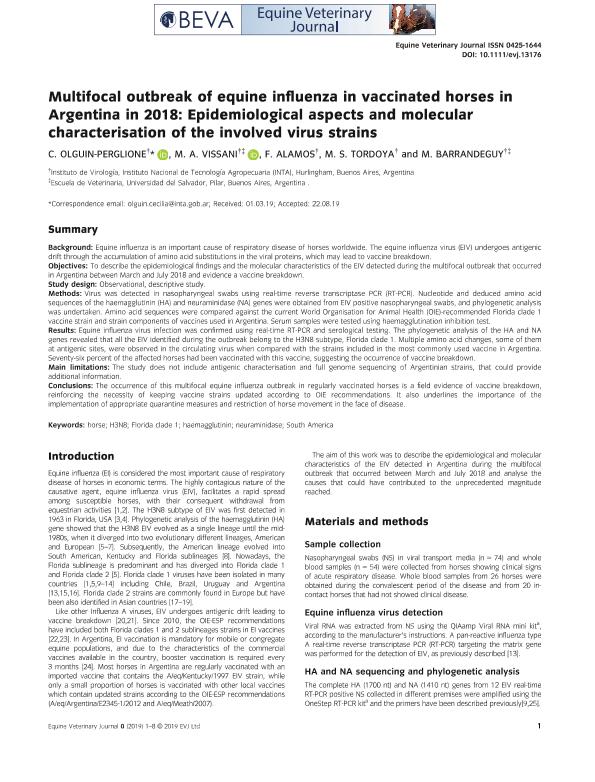Mostrar el registro sencillo del ítem
dc.contributor.author
Olguin Perglione, Cecilia

dc.contributor.author
Vissani, María Aldana

dc.contributor.author
Alamos, Florencia

dc.contributor.author
Tordoya, Maria Silvia

dc.contributor.author
Barrandeguy, M.
dc.date.available
2022-09-15T13:33:48Z
dc.date.issued
2020-05
dc.identifier.citation
Olguin Perglione, Cecilia; Vissani, María Aldana; Alamos, Florencia; Tordoya, Maria Silvia; Barrandeguy, M.; Multifocal outbreak of equine influenza in vaccinated horses in Argentina in 2018: Epidemiological aspects and molecular characterisation of the involved virus strains; Equine Veterinary Journal Ltd; Equine Veterinary Journal; 52; 3; 5-2020; 420-427
dc.identifier.issn
0425-1644
dc.identifier.uri
http://hdl.handle.net/11336/168901
dc.description.abstract
Background: Equine influenza is an important cause of respiratory disease of horses worldwide. The equine influenza virus (EIV) undergoes antigenic drift through the accumulation of amino acid substitutions in the viral proteins, which may lead to vaccine breakdown. Objectives: To describe the epidemiological findings and the molecular characteristics of the EIV detected during the multifocal outbreak that occurred in Argentina between March and July 2018 and evidence a vaccine breakdown. Study design: Observational, descriptive study. Methods: Virus was detected in nasopharyngeal swabs using real-time reverse transcriptase PCR (RT-PCR). Nucleotide and deduced amino acid sequences of the haemagglutinin (HA) and neuraminidase (NA) genes were obtained from EIV positive nasopharyngeal swabs, and phylogenetic analysis was undertaken. Amino acid sequences were compared against the current World Organisation for Animal Health (OIE)-recommended Florida clade 1 vaccine strain and strain components of vaccines used in Argentina. Serum samples were tested using haemagglutination inhibition test. Results: Equine influenza virus infection was confirmed using real-time RT-PCR and serological testing. The phylogenetic analysis of the HA and NA genes revealed that all the EIV identified during the outbreak belong to the H3N8 subtype, Florida clade 1. Multiple amino acid changes, some of them at antigenic sites, were observed in the circulating virus when compared with the strains included in the most commonly used vaccine in Argentina. Seventy-six percent of the affected horses had been vaccinated with this vaccine, suggesting the occurrence of vaccine breakdown. Main limitations: The study does not include antigenic characterisation and full genome sequencing of Argentinian strains, that could provide additional information. Conclusions: The occurrence of this multifocal equine influenza outbreak in regularly vaccinated horses is a field evidence of vaccine breakdown, reinforcing the necessity of keeping vaccine strains updated according to OIE recommendations. It also underlines the importance of the implementation of appropriate quarantine measures and restriction of horse movement in the face of disease.
dc.format
application/pdf
dc.language.iso
eng
dc.publisher
Equine Veterinary Journal Ltd

dc.rights
info:eu-repo/semantics/openAccess
dc.rights.uri
https://creativecommons.org/licenses/by-nc-sa/2.5/ar/
dc.subject
FLORIDA CLADE 1
dc.subject
H3N8
dc.subject
HAEMAGGLUTININ
dc.subject
HORSE
dc.subject
NEURAMINIDASE
dc.subject
SOUTH AMERICA
dc.subject.classification
Otras Ciencias Veterinarias

dc.subject.classification
Ciencias Veterinarias

dc.subject.classification
CIENCIAS AGRÍCOLAS

dc.title
Multifocal outbreak of equine influenza in vaccinated horses in Argentina in 2018: Epidemiological aspects and molecular characterisation of the involved virus strains
dc.type
info:eu-repo/semantics/article
dc.type
info:ar-repo/semantics/artículo
dc.type
info:eu-repo/semantics/publishedVersion
dc.date.updated
2022-09-15T02:15:17Z
dc.journal.volume
52
dc.journal.number
3
dc.journal.pagination
420-427
dc.journal.pais
Reino Unido

dc.description.fil
Fil: Olguin Perglione, Cecilia. Instituto Nacional de Tecnología Agropecuaria. Centro de Investigación en Ciencias Veterinarias y Agronómicas. Instituto de Virología; Argentina
dc.description.fil
Fil: Vissani, María Aldana. Universidad del Salvador; Argentina. Instituto Nacional de Tecnología Agropecuaria. Centro de Investigación en Ciencias Veterinarias y Agronómicas. Instituto de Virología; Argentina. Consejo Nacional de Investigaciones Científicas y Técnicas; Argentina
dc.description.fil
Fil: Alamos, Florencia. Instituto Nacional de Tecnología Agropecuaria. Centro de Investigación en Ciencias Veterinarias y Agronómicas. Instituto de Virología; Argentina
dc.description.fil
Fil: Tordoya, Maria Silvia. Instituto Nacional de Tecnología Agropecuaria. Centro de Investigación en Ciencias Veterinarias y Agronómicas. Instituto de Virología; Argentina
dc.description.fil
Fil: Barrandeguy, M.. Universidad del Salvador; Argentina. Instituto Nacional de Tecnología Agropecuaria. Centro de Investigación en Ciencias Veterinarias y Agronómicas. Instituto de Virología; Argentina
dc.journal.title
Equine Veterinary Journal

dc.relation.alternativeid
info:eu-repo/semantics/altIdentifier/doi/http://dx.doi.org/10.1111/evj.13176
Archivos asociados
